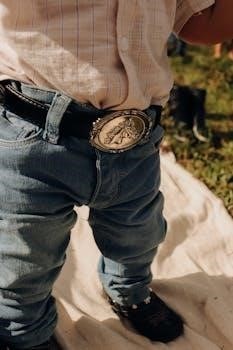
Understanding Boot Size Variations
Navigating boot sizes can be tricky due to global differences and manufacturer variations․ A size 3 boot from the US may differ from a UK size 3․ Always rely on length measurements, not just labeled sizes․ Variations in lasts also contribute to fit differences․
Global Size Differences
Boot sizing isn’t universal; global discrepancies exist significantly impacting fit․ A size 8 in the US is not always equivalent to a size 8 in the UK or Europe․ These variations stem from different measurement systems and manufacturing standards․ For example, European sizes often use whole numbers, while US sizes may include half sizes․ This lack of standardization can lead to confusion when purchasing boots from different regions․ Therefore, relying solely on a familiar size number without checking specific charts can result in ill-fitting boots․ When shopping, it’s crucial to consult size conversion charts provided by each brand or retailer, and prioritize foot length measurements over general size numbers․ This will help ensure you get the correct size, regardless of where the boots were manufactured or the sizing system used․ Remember, accuracy in measurements will help achieve the right fit․

Manufacturer Discrepancies
Even within the same region, boot sizes can vary significantly between manufacturers․ This is because each company uses unique “lasts,” the foot-shaped molds around which boots are constructed․ These lasts can differ in length, width, and overall shape, leading to variations even within the same labeled size․ Handmade boots, in particular, can have slight differences due to the nature of production and variations in leather thickness․ Furthermore, variations can occur because of humidity and the boot maker’s strength which can affect the fit․ A size 9 from one brand may feel tighter or looser than a size 9 from another․ This is why relying solely on your usual size isn’t reliable when choosing boots․ Always check the size charts provided by each manufacturer, and if possible, try on different brands to find the perfect fit for your foot shape and preferences․ This approach helps avoid common pitfalls of ill-fitting boots․

Measuring Your Feet Accurately
Accurate foot measurement is crucial for proper boot fit․ Measure both foot length and width, wearing the socks you intend to wear with the boots․ Use a flat surface and mark your heel and longest toe to determine the length correctly․
Foot Length Measurement
To accurately measure your foot length for boots, start by standing on a hard, flat surface with your heel against a wall․ Ensure you are wearing the socks you plan to wear with your boots․ Use a ruler or tape measure and a pen to mark the point at the end of your longest toe and also the point on the wall where your heel rests․ Make sure your pen is placed at a 90-degree angle to the floor when marking the toe․ The distance between these two points is your foot length․ It’s crucial to measure both feet as they may differ slightly, and use the measurement of the larger foot to determine your boot size․ Remember to measure in inches or centimeters, depending on the size chart you will be using․ If you’re between sizes, consider rounding up to the next half size to ensure comfort and proper fit, especially when boots don’t have the adjustability of shoes with laces․
Foot Width Measurement
Measuring foot width is crucial for a comfortable boot fit, as length alone doesn’t determine the right size․ To measure, you’ll need a ruler or tape measure, and you’ll be measuring the widest part of your foot․ This is typically across the ball of your foot, just below the toes․ Stand with your feet flat on a hard surface․ Measure the distance across the widest part of your foot, from one edge to the other․ Make sure the measuring tape is flat against your foot and not angled․ Record this measurement in inches or centimeters․ Compare your measurement with a boot width chart, which typically uses letters to denote widths (e․g․, B, D, EE, EEE)․ Keep in mind that widths are linear, with each step typically representing a difference of 3/16 of an inch․ Also, note that a “D” width is considered medium for men, while a “B” width is medium for women․ If your width measurement falls between sizes, it is generally recommended to choose the wider option to avoid discomfort and ensure proper circulation․

Boot Fit Considerations
Beyond length and width, consider calf circumference, instep, and arch fit․ New boots should feel snug, especially at the instep, arch and ball of foot․ Heel slippage is normal initially as boots conform to your foot․
Calf Width Measurement
Calf width is crucial for boot comfort, particularly with taller styles․ The boot opening, at the very top of the boot, should be measured inside․ This measurement helps determine if you need a standard, wide, or extra-wide calf fit․ Many boots, especially women’s styles, are offered in multiple calf widths․ To get an accurate measurement, sit with your feet flat on the floor․ Use a flexible measuring tape to measure the widest part of your calf․ Do this on both legs, as there may be a slight difference․ It is recommended that you wear the socks you intend to wear with the boots when measuring․ Some boots may have neoprene, which offers more flexibility to fit various calf shapes; Always consult the specific boot’s sizing chart for the most accurate guidance, as measurements can vary between brands and styles․ Understanding this measurement is essential for comfortable and well-fitting boots that don’t cause discomfort or restrict movement․
Instep and Arch Fit
The instep and arch fit are vital for overall boot comfort and proper support․ New boots should feel snug at the instep, arch, and ball of the foot․ This snugness is normal and will ease as the boots break in and conform to your foot’s shape․ A good fit in these areas prevents excessive heel slippage, which is also normal in new boots․ The boot’s design, including the last, significantly affects how it fits around the instep and arch․ Some boots are designed with specific arch support features for added comfort․ Pay attention to how the boot feels when you first try it on․ It should not feel too tight, but it should also not feel loose or unsupported in these crucial areas․ If you have a high instep, you may need to look for boots with more room or adjustable features․ A proper instep and arch fit ensures the boot stays securely on your foot and provides the necessary support for walking and other activities․

Using Boot Size Charts
Boot size charts are essential for finding the correct fit, especially when purchasing online․ These charts help convert between different regional sizing systems, like US, UK, and European sizes․ Always check the specific chart provided by the boot manufacturer․
Converting Sizes Between Regions
Converting boot sizes between regions is a crucial step when purchasing footwear from different countries․ Size variations exist between US, UK, European, and other systems․ For instance, a US size 9 might correspond to a UK size 8․5 or a European size 42․ These discrepancies stem from different measurement standards and last shapes used by manufacturers in different regions․ It’s important to consult specific conversion charts for each brand, as these can vary slightly․ When purchasing online, relying solely on your usual size number is risky․ Always measure your feet and use the provided size charts to find the correct fit․ Remember that even within the same region, brands can have their own slight variations in sizing․ This is why checking a specific brand’s size chart is very important․ For instance, a size 10 in one brand might feel like a size 9․5 in another․